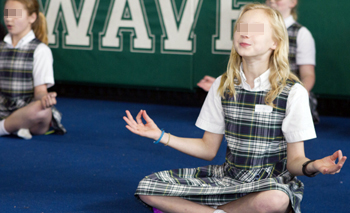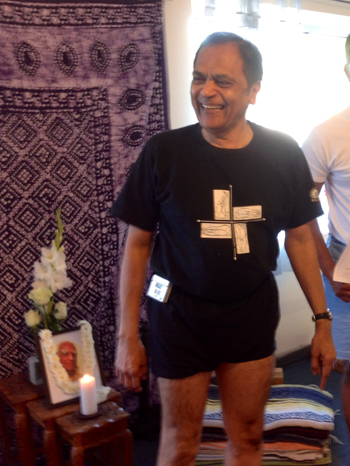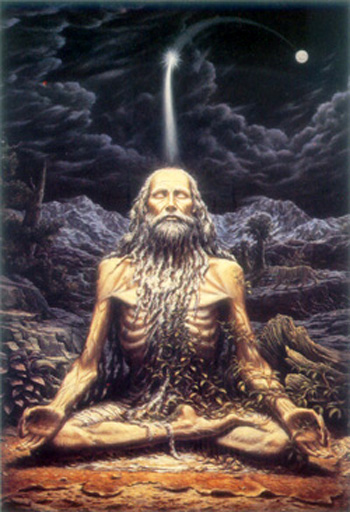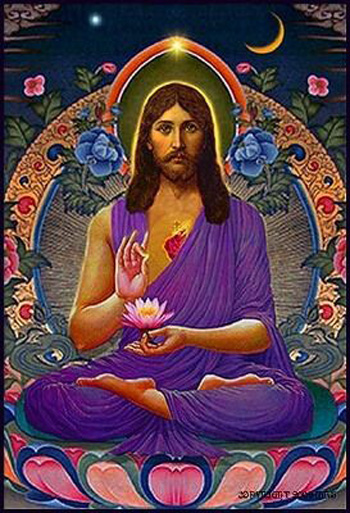Secret Forces & Gnosis
 |
 |
 |
 |
 |
 |
 |
Analyzing Reiki & Yoga- II
Yoga Is Incompatible with Catholicism
Fr. James Manjackal is a missionary priest in the Order of Missionaries of St. Francis de Sales. Although he is a progressivist priest and confessed charismatic preacher, we found his articles on the harmful effects of Yoga, Reiki and other Eastern practices well done. We hope his warning will be helpful to our readers. We have slightly edited these two articles by Fr. Manjackal to give them a less ecumenical language. TIA.
I am a Catholic born in a traditional Catholic family in Kerala, India, but I lived among Hindus. Now, as a Catholic priest and charismatic preacher in 60 countries on five continents, I have something to say about the harmful effects of Yoga on Catholic spirituality and life.
Students at a Catholic School practicing yoga as a means of meditation; below Fr. Joe Pereira travels the world teaching yoga

For some, Yoga is a means of relaxation and relief of stress, for others it is a form of exercise promoting fitness and health and for a minority it is a means of healing of sicknesses.
There is much confusion in the mind of the average Catholic – both lay and clergy – because the Yoga promoted among Catholics is not exclusively a discipline related to the health or entirely a spiritual discipline, but sometimes one, at other times, the other and often a mixture of the two.
But, in fact, Yoga is primarily a spiritual discipline and I know that there are even priests and sisters in the seminaries and novitiates who promote Yoga as an aid to meditation and prayer.
It is sad that today many Catholics are losing confidence in the great spiritual and mystical practices of prayer and discipline that they received from great saints like St. Ignatius of Loyola, St. Francis of Assisi, St. Francis of Sales, St. Theresa of Avila, etc. They now follow the Eastern spiritualities and mysticisms coming from Hinduism and Buddhism. In this regard a sincere Catholic should inquire into the compatibility of Yoga with the Catholic spirituality and the wisdom of incorporating its techniques into Catholic prayer and meditation.
Yoga is a union with an impersonal divinity
What is Yoga? The word Yoga means “union,” and the goal of Yoga is to unite one’s transitory (temporary) self, Jiva, with the infinite Brahman, the Hindu concept of god. This god is not a personal god, but an impersonal spiritual substance, which cannot be dissociated from nature and the cosmos.

Yogi Patanjali achieving union with the all, the divine energy inside everything
“The absolute is within oneself” says the Chandogya Upanishads, it is the “tat tvam asi” or “thou that art.” That is to say, the divine dwells within each one of us through his microcosmic representative, the individual self called Jiva. In the Bhagavad Gita, the Jiva is described as immutable, eternal, numberless, indestructible and of a higher “spiritual” nature.
At the point of physical death it is the Jiva that takes a new physical body depending on the karma of the particular Jiva in question. Karma is the sum of a person's actions in this and previous states of existence, viewed as deciding their fate in future existences. The lord Krishna calls the Jiva “my own eternal portion,” and states that “the joy of Yoga comes to the yogi [the one who practices Yoga] who is one with Brahman.”
In 150 A.D., the yogi Patanjali explained the eight ways that leads the Yoga practices from ignorance to enlightenment. The eight ways are like a staircase; they are self-control (yama), religious practice (niyama), postures (asana), breathing exercises (pranayama), control of the senses (pratyahara), concentration (dharana), deep contemplation (dhyana) and, finally, enlightenment (samadhi).
It is interesting to note that postures and breathing exercises, often considered in the West to be the whole of Yoga, are actually steps 3 and 4 towards union with Brahman.
Yoga is a spiritual discipline
Yoga is not just an elaborate system of physical postures and exercises. It is a spiritual discipline that purports to lead the soul to enlightenment (samadhi), total union with the divine being. Samadhi is the state in which the natural and the divine become one, man and God become one without any difference. (1)

Christ portrayed as a yoga master
It is sad that some promoters of Yoga, Reiki and other disciplines and meditations distort and misuse some quotes from the Bible to substantiate their arguments, such as “You are the temple of God,” “The living water flows in you,” “You will be in me and I will be in you,” “It is no longer I that lives but Christ who lives in me” etc. without understanding the context and the meaning of those words in the Scripture.
There are even people who portray Jesus as a yogi, as we currently see in pictures of Jesus in convents, chapels and presbyteries – Jesus presented in yogi postures in meditation.
To call Jesus “a yogi” is to deny His divinity, holiness and perfection and suggest that He had an imperfect nature subject to ignorance and illusion (Maya) and needed to be liberated from the human condition through the practice and discipline of Yoga.
Continued
- Brad Scott, "Exercise or religious practice? Yoga: What the teacher never taught you in that Hatha Yoga class,” The Watchman Expositor, vol. 18, n. 2, 2001

Posted May 4, 2016
______________________
______________________
 Volume I |
 Volume II |
 Volume III |
 Volume IV |
 Volume V |
 Volume VI |
 Volume VII |
 Volume VIII |
 Volume IX |
 Volume XI |
 Special Edition |
 Special Edition |


